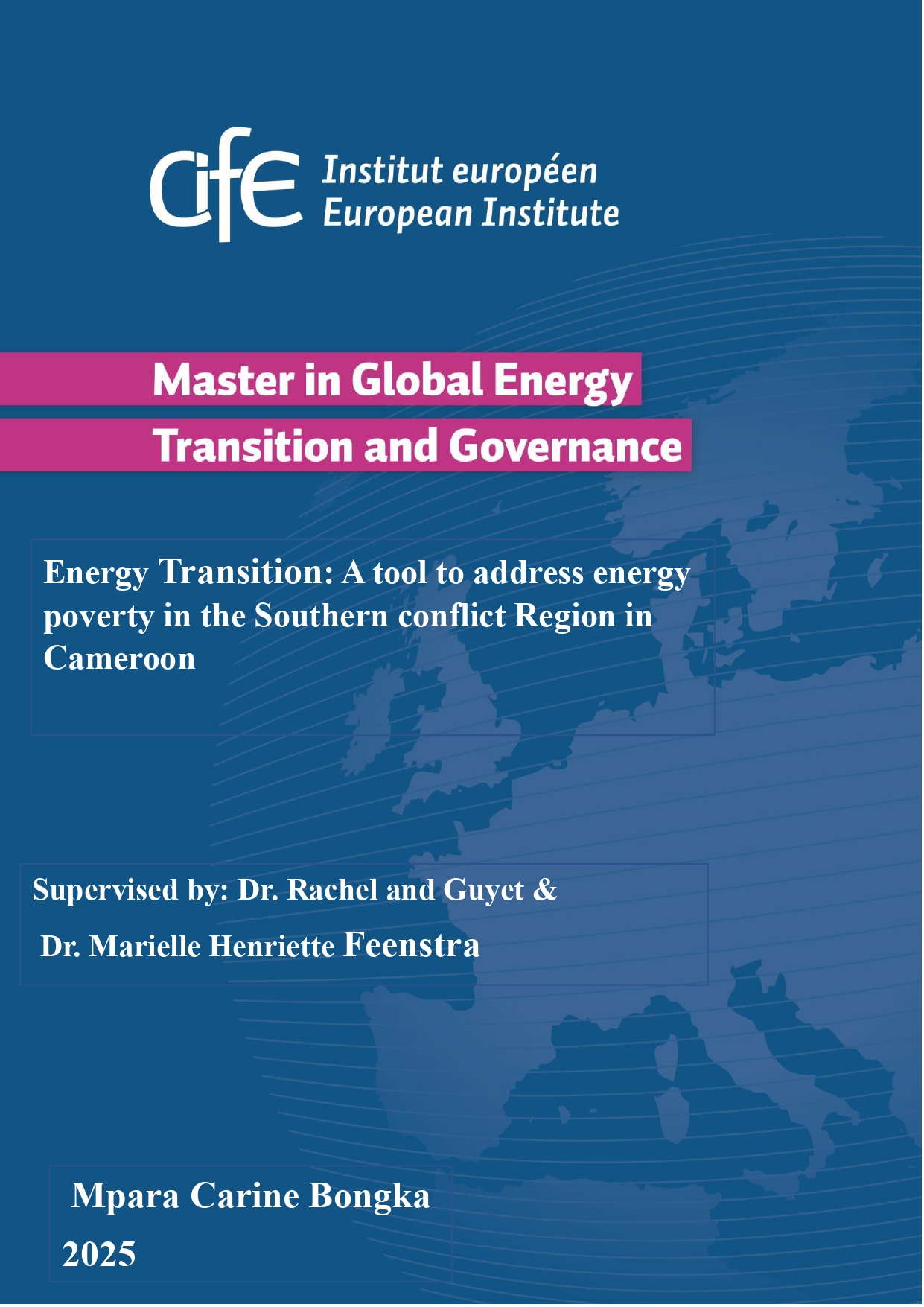Energy Transition: A tool to address energy poverty in the Southern conflict Region in Cameroon
Masters Thesis
Author: Carine Bongka Mpara
2025
Citation
Mpara, C.B. (2025) Energy Transition: A tool to address energy poverty in the Southern conflict Region in Cameroon

Executive Summary
| Date | 2025 |
| Author | Carine Bongka Mpara |
| Supervisors | Dr. Rachel Guyet Dr. Mariëlle Feenstra |
Introduction
Securing access to sustainable and affordable energy remains a critical challenge in conflict-
affected regions worldwide. While global energy transitions have spurred the adoption of
renewable energy and policy reforms, energy poverty persists, particularly in sub-Saharan
Africa. Initially defined in the United Kingdom as a household’s inability to afford adequate
heating, energy poverty now encompasses broader issues, including electricity access,
dependence on inefficient fuels, and the socioeconomic impacts of energy deprivation.
Despite energy being fundamental to economic growth and human development, 600 million
people in sub-Saharan Africa still lack access to modern energy services [1] . This lack of
access is not solely due to resource scarcity but is often exacerbated by political instability,
weak governance, poor infrastructure, and ongoing conflicts. Southern Cameroon, a region
experiencing ongoing conflict is faced with acute energy poverty. In these areas, energy
poverty manifests as the absence of sustainable, equitable, and reliable access to modern
services, as outlined by the World Economic Forum [2,3] . As a result, communities in the region
experience deep energy injustice and are forced to rely on inefficient and polluting energy
sources. Given the severity of energy poverty in these regions, this study aims to examine
whether Cameroon’s current energy policies address the unique challenges in the southern
region using the energy trilemma: energy security, sustainability, affordability, and energy
justice, which emphasizes fair and equitable access to energy for all.
History
Cameroon has made significant commitments to extend and expand electricity access, with
strategic plans such as the National Development Strategic Plan (SND30) 2020-2030, to
increase electricity production and an ambitious goal of achieving universal access by 2035 [4] .
The country also aims to increase the energy mix by 25%, incorporating more renewable
sources into its grid. Despite these national efforts, the underdevelopment of centralized
electricity infrastructure and governance structure continues to pose challenges for many
underserved communities, particularly in remote areas and in conflict-affected regions.
One of the most pressing concerns is the situation in Southern Cameroon, where over 60% of
communities have been without electricity since 2018. In addition to this severe energy
poverty, weak telecommunication infrastructure further isolates residents, leaving them
without reliable network access and critical information. This continued lack of essential
services deepens their vulnerability, exacerbating socio-economic hardships. While broader
electrification strategies exist, little effort has been made to tailor energy policies to the unique challenges faced by the conflict-affected southern region. Against this, the central
question guiding this research is:
Does Cameroon’s current energy policies take into consideration the specific energy
challenges of the Southern conflict in Cameroon?
Methodology
This study employed an analytical framework combining the Energy Trilemma and Energy
Justice principles to assess energy policies in Cameroon. The Energy Trilemma provides a
structured approach to evaluate policies based on energy security, affordability, and
sustainability, ensuring a balance between these competing priorities. However, Energy
Justice introduces a critical social perspective, highlighting fairness, inclusion, and equity in
policymaking beyond technical and economic considerations. Since policies in Cameroon
often reflect historical injustices and governance challenges, integrating both frameworks
allows for a comprehensive analysis of whether current policies and plans contains features
which can adequately address energy insecurity and inequalities in Southern Cameroon.
Results
The analysis reveals that the policies lack targeted measures to address the unique energy
needs and mechanisms to restore energy access of the conflict affected Southern Cameroon.
It also fails to address historical injustices that persist in southern conflict regions as their
needs have not been recognized.
Additionally, it also reveals that this failure to recognize and address their unique energy
challenges is demonstrated by gaps in policy which are underlain by some root causes. They
include a path dependency approach resulting in a lack of political will, governance failures
such as fragmented institutional mandates, weak coordination, and insufficient transparency
which does allow for inclusive and sustainable development.
Recommendations
The analysis reveals that Cameroon faces complexities in the energy landscape and the
challenges posed by the conflict in the southern region; a comprehensive and unique
approach to energy governance and policy reform is necessary. To effectively address the root
causes of the gaps in the energy landscape and polices that affect access to sustainable and
equitable energy, including path dependency, lack of political will, and inadequate institutional frameworks, Cameroon can learn from countries that have experienced similar
challenges and have successfully implemented reforms.
- Adopt a Post-Conflict Energy Reconstruction Framework and Establish a
Specialized Energy Task Force for the Southern Region: One potential approach is
to adopt a post-conflict reconstruction framework for the energy sector, similar to the one
implemented in Rwanda after the 1994 genocide. Rwanda’s experience in rebuilding its
energy infrastructure and promoting sustainable energy development [5,6] can provide valuable
insights for Cameroon. For example, Rwanda’s focus on decentralized energy solutions,
community participation, and renewable energy development can help Cameroon promote
energy access and sustainability in the southern conflict region. They can go about it by
establishing a special task ministry, force, or agency responsible for coordinating energy
development plans in the southern conflict region, where they would work together with the
local communities, stakeholders, and international organizations to identify areas of priority
for energy development, developed a specific energy plan and implement projects that
facilitate energy access and sustainability. - Implement Inclusive, Participatory Energy Planning: In addition to learning from
Rwanda’s experience, Cameroon can also benefit from adopting a more inclusive and
participatory approach to energy planning and decision-making. This can involve engaging
with local communities, stakeholders, and conflict-affected populations in the decision-
making process [5,6] . It can be done through a round table discussion to ensure that their needs
and priorities are taken into account in energy policy design for effective addressing and
implementation. Progress can be measured by the level of community engagement and
participation in energy decision-making, and checking the increase in energy access rates in
the southern conflict region. - Prioritize Institutional Strengthening and Capacity Building: To address the
challenges posed by path dependency and inadequate institutional frameworks, Cameroon
can prioritize institutional strengthening and capacity building in the energy sector. This can
involve establishing clear mandates and responsibilities for energy institutions, promoting
transparency and accountability, and investing in capacity-building programs for energy
officials and stakeholders. - Prioritize Institutional Strengthening and Capacity Building: To overcome the
silo approach and coordination challenges that hinders or delays energy development in
Cameroon and the impact in the southern conflict region, Cameroon can establish an inter-
ministerial coordination committee on energy development. This committee can call on
representatives from various government ministries and agencies, local communities, and
stakeholders to ensure a coordinated and integrated approach to energy planning and
decision-making. Promoting collaboration and coordination among different stakeholders in
Cameroon can ensure that energy policies and programs are designed and implemented in a
way that addresses the unique challenges and needs of the southern conflict region. It would
also help to avoid duplication of efforts among different government ministries and agencies,
leading to effective resource allocation. - Review and Revise the Electricity Law to Address Gaps: After considering the
above suggested steps, the government should review and revise the Electricity Law making
it to capture the gaps in the dimensions it lacks. To also ensure it is aligned with tools,
mechanisms and measures to address the energy needs of the southern conflict region.
Promoting access to sustainable energy development, and provides a framework for
decentralized energy solutions and community participation - Commit to a Holistic Strategy for Sustainable and Equitable Energy Access:
Adopting a post-conflict reconstruction framework, prioritize institutional strengthening,
establish an inter-ministerial coordination force, policy reform, and prioritizing inclusive and
sustainable energy development, Cameroon can promote equitable access to sustainable
energy in a just way, in the southern conflict region, and ensure that energy development
contributes to the country’s overall development and stability.
References
- International Energy Agency. (n.d.). Africa. Retrieved from
https://www.iea.org/regions/africa - World Economic Forum, “Energy Poverty Action,” (2010). Retrieved from
https://www.habitat.org/emea/about/what-we-do/residential-energy-efficiency-
households/energy-poverty - Heffron, R. J., & McCauley, D. (2025). Addressing energy poverty: Regional trends and examples of best practice. Energy for Sustainable Development. Retrieved from https://www.haw-hamburg.de/fileadmin/LS/FTZ-NK/PDF/Publications/2025-
- Ministry of Economy, Planning and Regional Development. (2020). National Development Strategy 2020-2030: For Structural Transformation and Inclusive Development. Retrieved from https://www.effectivecooperation.org/system/files/2022-01/NATIONAL_DEVELOPMENT_STRATEGY_2020_2030.pdf.
- World Bank. (2023). Rwanda: Energy Access and Quality Improvement Project. https://projects.worldbank.org/en/projects-operations/project-detail/P172594
- USAID. (2023). Power Africa: Rwanda Energy Sector Overview. https://www.usaid.gov/powerafrica/rwanda

